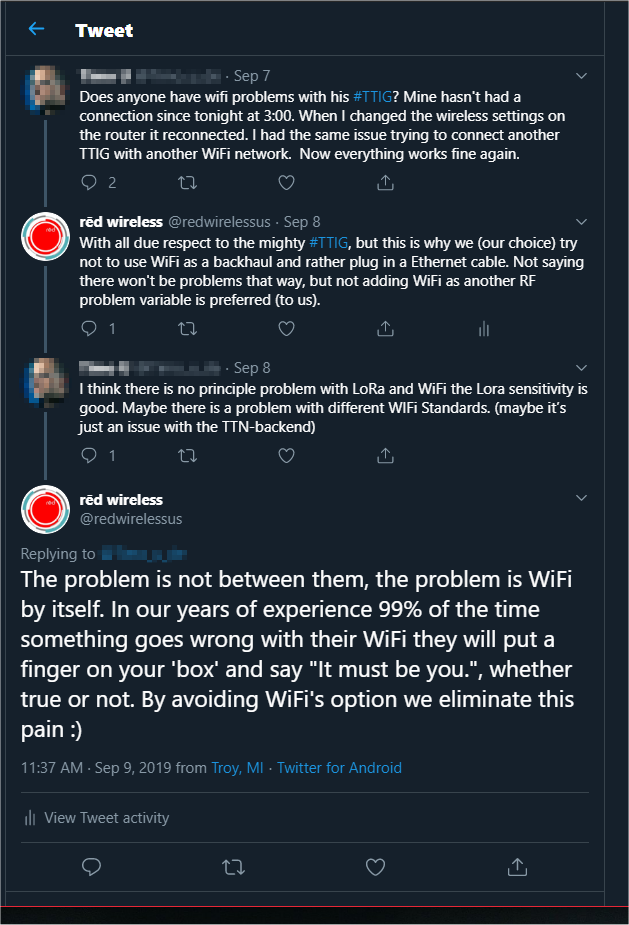The only difference in Bootlogs is as follows:
1970-01-01 00:00:05.276 [SYS:DEBU] Free Heap: 55888 (min=55456) wifi=1 mh=3 cups=0 tc=0
scandone
state: 0 -> 2 (b0)
state: 2 -> 2 (8a0)
state: 2 -> 0 (2)
reconnect
Sorry fo my Poor English, Sorry, for the bad descriptions
09.09.2019:
I’ve tested the TTIG connected to a mobile Hotspot (Smartphone) this morning.
Same problems as above …
After a Power Cycle Connection gets lost after sending the first packet, LED constant green
only pressing setup 10 sec, waiting some secs until blinking slowly red and then pressing setup for 5 sec did recover it
So I think it isn’t a matter of my WLAN Setup
Same Results if connected to Fritzbox, Cisco AP, Asus AP and mobile Hotspot
Any Suggestions ?
Should I complain on RS-Components a second time ?
Or throw away the dammned thing as suggested in the first posts ?
If I terminate and reenable the mobile Hotspot, things go wrong again …
same as power cycling the TTIG
After loosing connection the TTIG reboots (as seen in the Debug Output) and rescans immediately the WLAN. If the AP is available in this scan, things go wrong as described above.
If I switch on the AP AFTER this first rescan, the TTIG rescans the WLAN after about 30 s a second time (without rebooting), finds the AP and things go right … TTIG functions properly
But there’s no workaround in case of
- short power loss
- short wifi loss
Why the reboot if WIFI gets lost more then 1 sec ?
Maybe a Bug …
Anybody out there who may verify this reboots ?
@bei: I’m not allowed to post a reply for the next 5 hours …
Here’s my Setup:
@bei: I have a simple TTN Node (Arduino+RFM95) which sends a Temparature Packet every 15 secs. After the described faulty reboot the TTIG forwards exactly 1 Packet … seen in the TTN Console of Gateway and Device. Logging the DEBUG Output of the TTIG doesn’t show any differences between “good” and “bad” state. The TTIG receives all Packets sent by the Node but stops forwarding them after the first sent packet. This is the condition ‘connection gets lost after sending the first packet’. If I activate my DIY 1ch RASPI GW, this GW forwards exactly every 8th Packet (1ch of 8) without any Problems over the same Infrastructure.
@bel: I think I should wait the 4 hours to be permitted for replying …
TTIG Debug Output in failure state doesn’t differ from “good” state:
- 2019-09-09 08:37:08.883 [S2E:VERB] RX 867.7MHz DR5 SF7/BW125 snr=10.0 rssi=-12 xtime=0x77000005C08C3C - updf mhdr=40 DevAddr=26011CB2 FCtrl=80 FCnt=870 FOpts=[] 01AFB05F mic=2133244814 (16 bytes)
- 2019-09-09 08:37:09.298 [SYS:DEBU] Free Heap: 18872 (min=17064) wifi=5 mh=7 cups=8 tc=4
and yes, I’m looking at the TTN Console Traffic Page of the GW
Packet Capture maybe next weekend, i have to recover an old WRT54G or is it possible to do a capture on my Android Smartphone ?

